- Back to Home »
- When the top cop is a woman
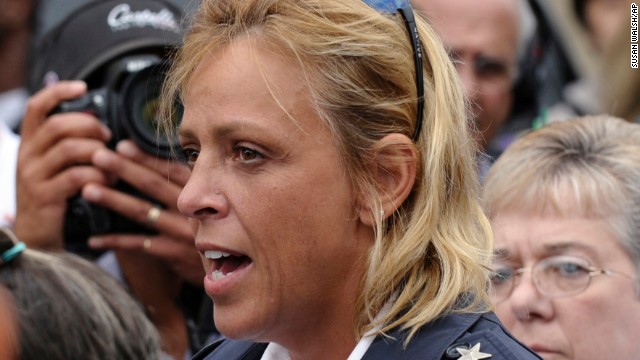 District of Columbia Police Chief Cathy Lanier speaks to reporters at Washington Navy Yard on Monday, September 16. She said the mass shooting, which left at least 12 people -- and the suspect -- dead, was "one of the worst things we've seen." Many of the people directing the official response to the horrific incident are women.
District of Columbia Police Chief Cathy Lanier speaks to reporters at Washington Navy Yard on Monday, September 16. She said the mass shooting, which left at least 12 people -- and the suspect -- dead, was "one of the worst things we've seen." Many of the people directing the official response to the horrific incident are women. 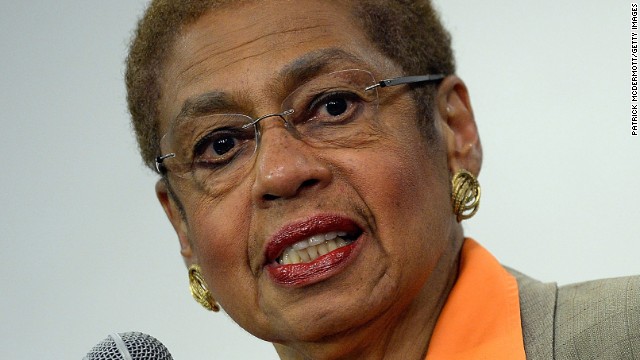 Rep. Eleanor Holmes Norton, D-Washington, briefs members of the media at a Washington government building on September 16. "Washington needs a lot more answers," Norton said in an interview with CNN on Tuesday, September 17.
Rep. Eleanor Holmes Norton, D-Washington, briefs members of the media at a Washington government building on September 16. "Washington needs a lot more answers," Norton said in an interview with CNN on Tuesday, September 17. 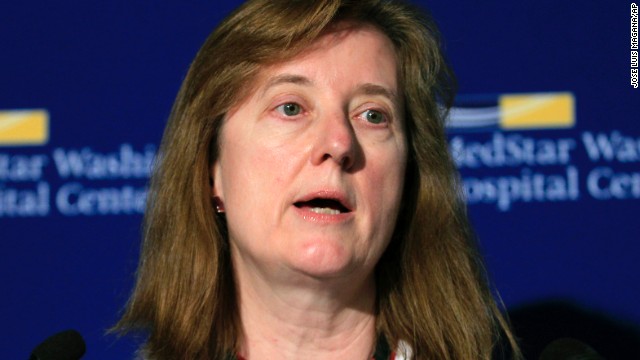 Dr. Janis M. Orlowski, chief operating officer at MedStar Washington Hospital Center, speaks at a news conference on September 16. She was tasked with treating many of the wounded after the rampage at the Navy Yard, and desires a day in which her job becomes obsolete. "You know what America? Put me out of business," she said. "Make it so I don't have to have a trauma center."
Dr. Janis M. Orlowski, chief operating officer at MedStar Washington Hospital Center, speaks at a news conference on September 16. She was tasked with treating many of the wounded after the rampage at the Navy Yard, and desires a day in which her job becomes obsolete. "You know what America? Put me out of business," she said. "Make it so I don't have to have a trauma center." 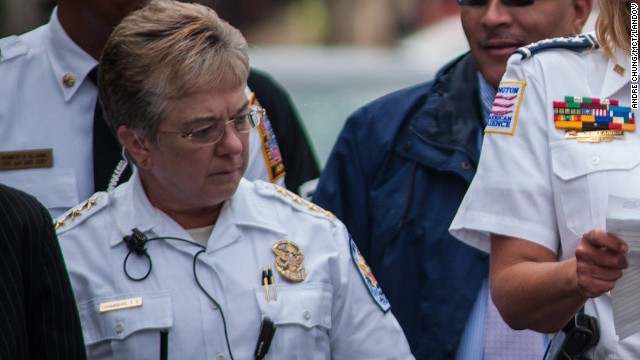 U.S. Park Police Chief Teresa Chambers walks to a press conference on September 16. "We will be a part of this ongoing and fluid investigation," she told reporters.
U.S. Park Police Chief Teresa Chambers walks to a press conference on September 16. "We will be a part of this ongoing and fluid investigation," she told reporters. 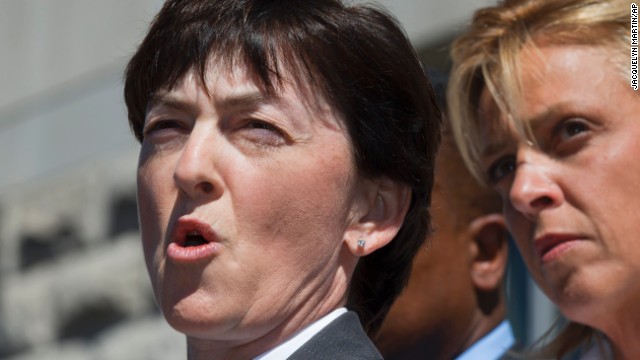 Valerie Parlave, assistant director in charge of the FBI's Washington Field Office, speaks at a news conference on Tuesday, September 17. Authorities are still searching for more information about the gunman, Aaron Alexis, and they're asking the public for help. "No piece of information is too small," Parlave said.
Valerie Parlave, assistant director in charge of the FBI's Washington Field Office, speaks at a news conference on Tuesday, September 17. Authorities are still searching for more information about the gunman, Aaron Alexis, and they're asking the public for help. "No piece of information is too small," Parlave said. - Peggy Drexler: Female law-enforcement officials prominent in Navy Yard shootings
- She says D.C. police chief, U.S. park police chief and FBI's field office director are all women
- She says it's remarkable - -and good -- that little is made of this, given male-dominated field
- Drexler: More women are top-ranked cops today as "brass ceiling" steadily cracking
Editor's note: Peggy Drexler is the author of "Our Fathers, Ourselves: Daughters, Fathers, and the Changing American Family" and "Raising Boys Without Men." She is an assistant professor of psychology at Weill Medical College of Cornell University and a former gender scholar at Stanford University. Join her on Facebook and follow her on Twitter @drpeggydrexler.
(CNN) -- While following the horrific events at the Washington Navy Yard, I was struck by something beyond the tragic developments. It was the number of women in law enforcement who were directing the response to those events, and who were center-stage -- at press conferences, in news articles and on my TV screen — as they updated the public.
They included Cathy Lanier, chief of District of Columbia's Metropolitan Police Department; Valerie Parlave, assistant director in charge, FBI's Washington Field Office; Teresa Chambers, chief of the United States Park Police and they have largely been the face of officialdom in the Navy Yard shootings.

The gender of these women so prominent in handling the unfolding crisis has gone unmentioned — and this alone is worthy of note, considering the history of women in law enforcement, long a male-dominated profession. These women are simply law enforcement leaders doing the jobs they were hired to do. And there are more: Women also head the U.S. Marshal's Service, the Secret Service, the Drug Enforcement Administration and Amtrak Police Department.
This kind of representation is relatively new.
Women have worked in law enforcement since the 19th century. But until the 1970s, they were mainly confined to clerical jobs or dispatch. Affirmative action opened doors, but just a crack. Women back then still held only 2% of total police force jobs. Today, FBI figures put the total number of women in law enforcement at around 12% of the nation's roughly 700,000 police officers -- with representation highest in big city departments, where females can account for as many as one in four.
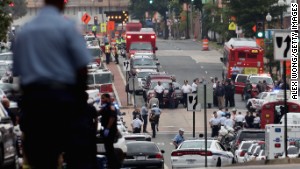 At least 12 dead in Navy Yard shooting
At least 12 dead in Navy Yard shooting 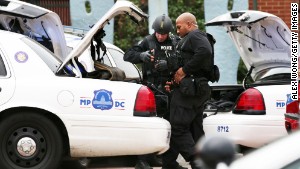 Witnesses recount the Navy Yard shooting
Witnesses recount the Navy Yard shooting In wasn't until 1985 that America saw a major city swear in its first female police chief, when Penny Harrington took the job in Portland, Oregon. Since then, the chief has been addressed as "ma'am" in Boston, San Francisco, Milwaukee, Detroit, Orlando, Houston, Tampa and dozens of smaller cities. The most recent figures from the National Association of Women Law Enforcement Executives indicate there are approximately 220 female police chiefs across the country.
The rise to top leadership positions in law enforcement bumps up against the same barriers as other professions, of course. Female officers call it the "brass ceiling." (aka "the bulletproof glass ceiling"). The pioneering chief Harrington (who resigned after a rough tenure) talked about that in an interview in Next Women Business Magazine. Harrington, founder of the National Center for Women and Policing, said: "Unfortunately, the obstacles have not changed much since I started in 1964. The culture still values physical strength and devalues reasoning and negotiating skills."
She also said that because so many officers start in the military, "they bring those rigid attitudes with them." She added, however, that there are "many wonderful men in law enforcement who are supportive of women, and who are excellent community officers."
D.C. Chief Lanier agreed that the march to the top still has pitfalls. She told USAToday last month: "There is a segment of the population that is still watching, waiting and hoping that we don't do well." Still, she cites accomplishments in the 40 years since women were allowed to join men in patrol cars. Women represent 22% of the D.C. police force. "Women (officers) are paying attention to what's happening in the top ranks. ... I think, overall, people are starting to appreciate these changes."
There is clearly room to improve, but as the women handling the Washington Navy Yard crisis so powerfully show, the brass ceiling -- like the glass ceiling -- has begun to crack.
Follow us on Twitter @CNNOpinion.
Join us on Facebook/CNNOpinion.
The opinions expressed in this commentary are solely those of Peggy Drexler.







